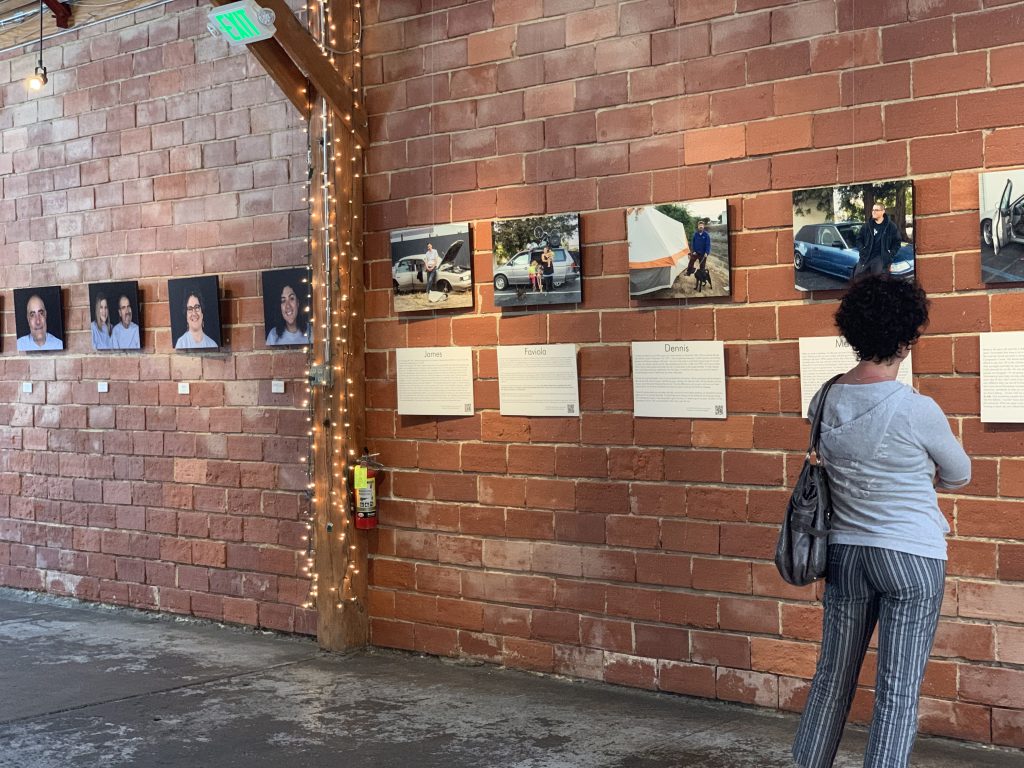
Gallery-goers look at Bassendine’s portraits on the wall of Warehouse 416 in Downtown Oakland. (Julia Irwin)
Fine art photographer Kirti Bassendine was appalled when friends returning to England from their visit to San Francisco posted vitriolic sentiments about the SF’s “homeless problem” to their social media page; voicing their disgust with the trash, needles, feces, and people on the streets, they warned others not to visit.
“It made me realize that this has to change,” said Bassendine. “This image that we’re seeing, the negativity—ev- eryone is getting the idea that these people are like animals, and they’re not. They’re human beings.”
Bassendine created her multimedia project, “Voiceless,” with a goal of humanizing the face of homelessness. “The mission is to create awareness and compassion,” Bassendine said. “There’s so much numbing—you walk around these major cities, you see the trash and the tents, and suddenly, people are numb. I wanted to bring humanity back.”
‘Even the person stocking the shelves of the grocery store you go to might be sleeping on the street.’
Following showings in Gilroy and Sacramento, “Voiceless” was exhibited at Warehouse 416 in Downtown Oak- land on July 5, 6, and 13. It includes video interviews, several stand-alone photographs, and “Neutral Spaces,” an interactive pair of photo series’ de- picting unhoused persons and people who volunteer at homeless shelters
The entry corridor greets viewers with the first series of portraits, depicting smiling subjects all dressed in a plain gray t-shirt, set against a basic black background. As the viewer moves along the red brick wall and into the gallery space, they come upon the second series of portraits, portray- ing these same people in their own clothes, situated against the back- grounds of their realities—volunteers stand beside their organizations’ head- quarters; unhoused people are pic- tured with the cars or tents they sleep in. Each of these photographs is paired with a storyboard, through which the subjects give written context to their situations. The opposite wall features a few stand-alone, local shots, and several short films are projected onto the adjacent wall, allowing viewers to hear stories told by unhoused people in their own voices.

Bassendine and Jake pose in front of Jake’s portrait. (Julia Irwin)
“It’s about neutrality—you see these close-ups, just regular portraits, and it’s hard to know who’s homeless and who’s not. James here could easily be working for Home Depot, or at an IT company; he could be the owner of a grocery store,” said Bassendine. “Then you go to the environmental stories, and you’re like, wow, he lives in a beat-up car.”
For Jake, one of the unhoused peo- ple pictured in Bassendine’s photo- graphs, the importance of the project lies in this ability to humanize home- lessness.
“A lot of people have stereotypes about homeless people, and they nev- er bother to talk to us, so all they have is this secondhand perspective,” he said. “This project exposes the hidden side of homelessness, that even the person stocking the shelves of the gro- cery store you go to might be sleeping on the street.”
The project, which had long since been on Bassendine’s mind, came to fruition in September of 2018, when the photographer met Sally, a recently unhoused woman living near a shelter in Gilroy. “She just absolutely touched me, having gone through her spouse dying, losing a home, being out on the streets,” said Bassendine, “and it just made me realize, ‘My gosh, I’m a woman of her age. How would I survive even for one day?’
Bassendine’s work is grounded in an empathetic approach: the photog- rapher works in partnership with the local community, through shelters or advocates, to find unhoused people interested in telling their stories. “I don’t just go out and take random pictures—it’s not about that quick snippet, it’s about getting to know the person,” Bassendine said. “And it’s about trust—for someone to sit and tell you their story, they have to trust me that I’m going to do it right. Otherwise, I’m putting them out there in the open.”
Finding funding for her project has been a thorn in Bassendine’s side. “So many films need to be created; I need to improve some of the film quality and add more portraits. I can’t contin- ue without it,” Bassendine said.
Once she secures funding, Bassen- dine hopes to take “Voiceless” to cities across the country, adding local stories at each stop.
“I want to get conversations started to effect community-level and pol- icy-level change,” said Bassendine.
“I want people to start seeing what’s around them, and asking what they can do in their areas to support their neighbors.”
Julia Irwin is a writer, a recent UC Berkeley graduate, and a soon-to-be law school student.
